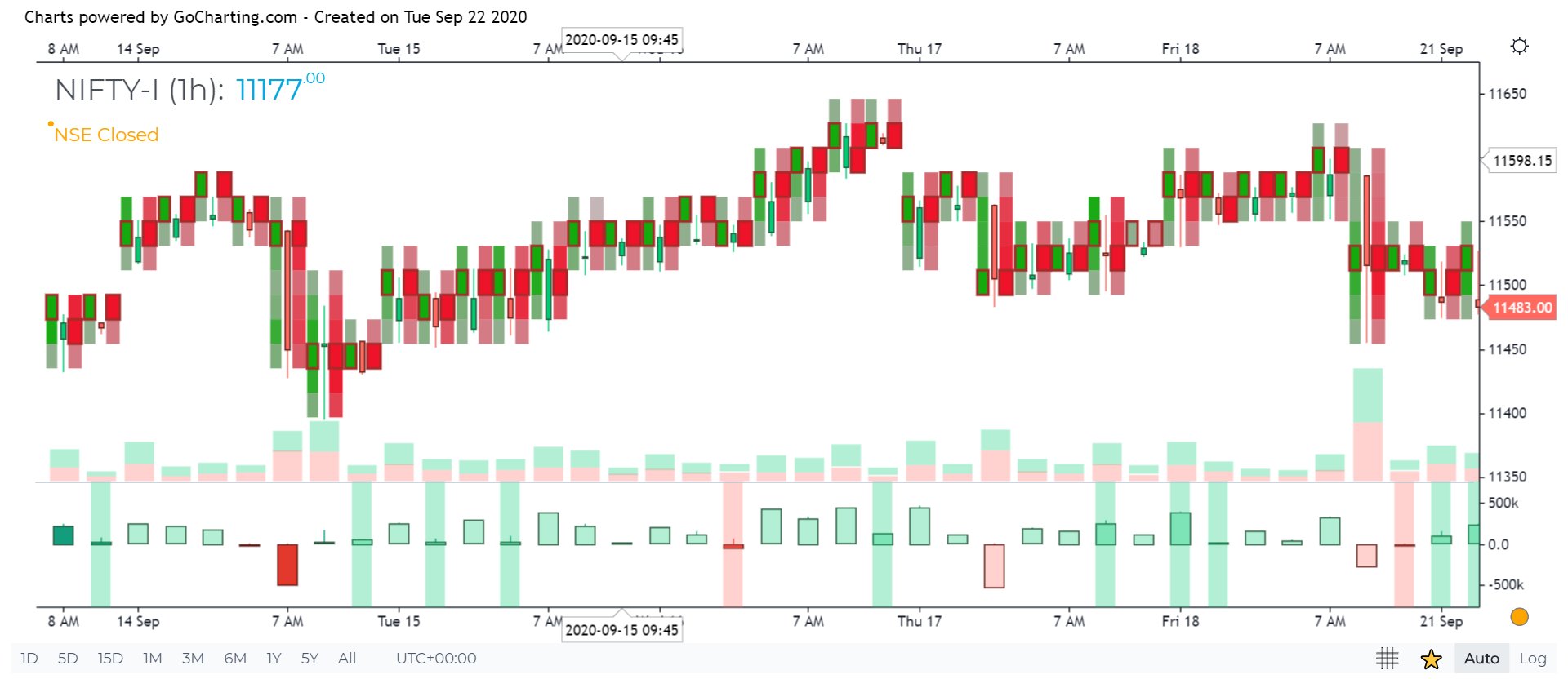Delta and Cumulative Delta Bars
What is Volume Delta?
Volume Delta is the difference between buying and selling power. Volume Delta is calculated by taking the difference of the volume that traded at the offer price and the volume that traded at the bid price.
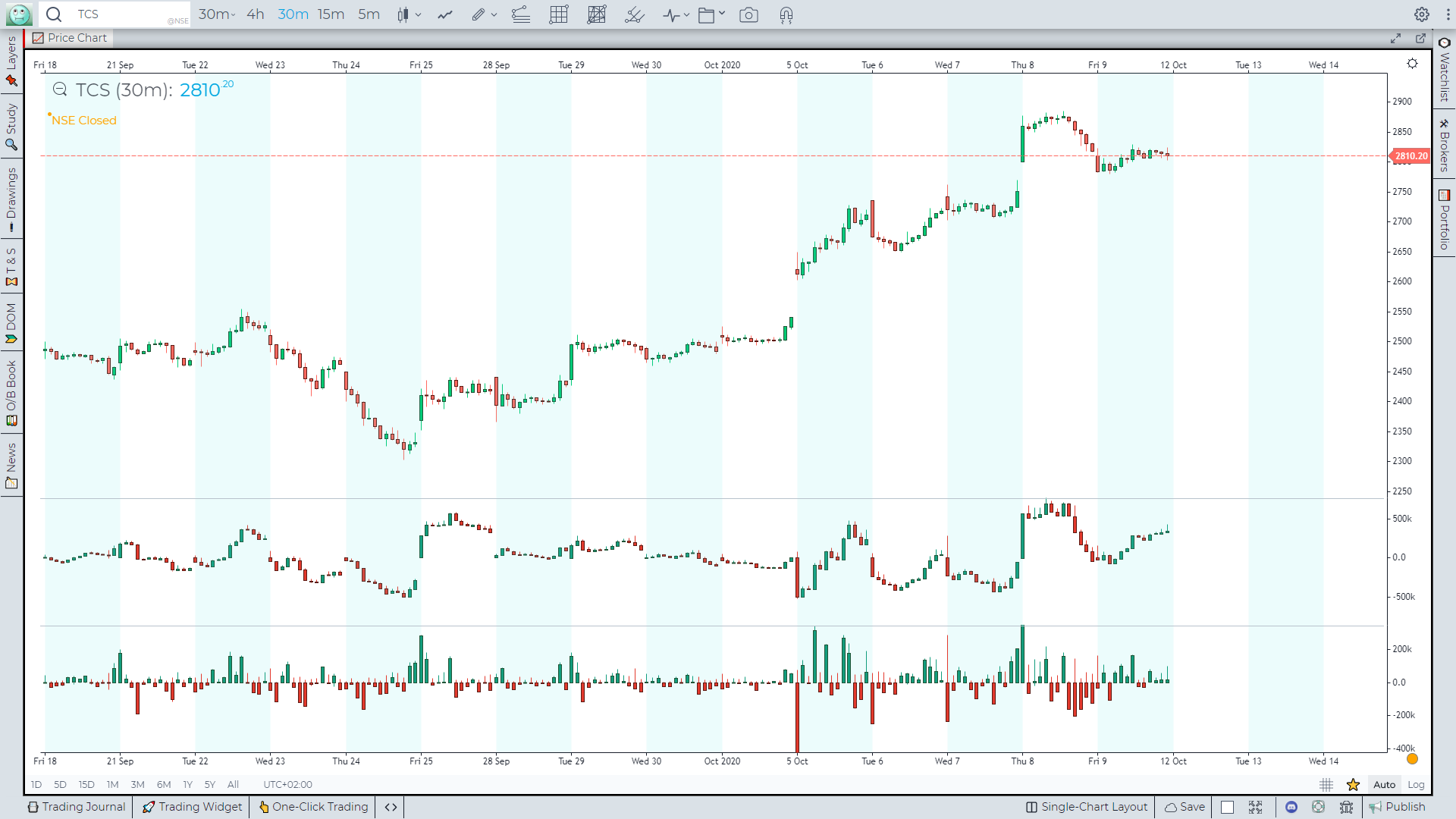
DELTA = BUY Volume – SELL Volumes
- Delta = Positive => Aggressiveness on the Buy side
- Delta = Negative => Aggressiveness on the Sell side
If delta is greater than 0 you have more buying than selling pressure. If delta is less than 0, you have more selling than buying pressure.
In the below chart, we added the Bar Statistics indicator and added Delta to the candle metrics summary table. We see that when there is more Buying than Selling (Delta=Positive), the price candle is Green and when there is more Selling than Buying (Delta=Negative), the price candle is Red.
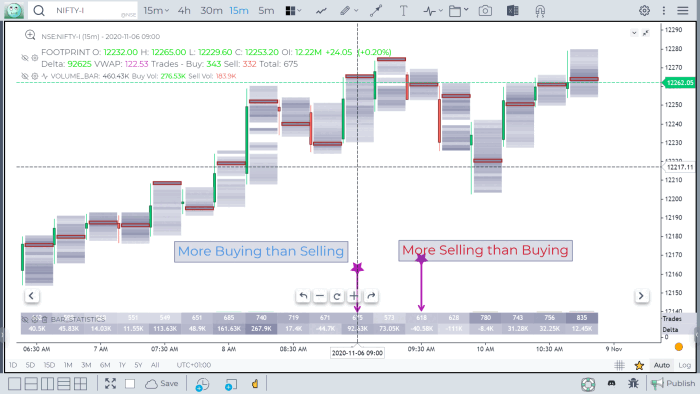
We use delta to understand the relationship between buying or selling pressure and price.
Let’s imagine a price bar that reached the low for the day but delta was actually positive and the bar closed higher than it opened.
In simple terms we can describe this as:
- Price made a new low
- The bar closed higher
- Delta demonstrated more buying than selling
Without looking at the chart below, would you be more inclined to do, go Long or Short?
If you said Long you were correct
Volume delta is a key metric to understand when making trading decisions based on volume and order flow. However, on its own it can be too much information to interpret quickly when trading in a volatile market.
What are Delta Bars
Delta Bars is a candlestick representation of Delta. In other words, it has an Open, High (also called Delta Max), Low (also called Delta Min) and Close point in every candle (1min, 5min, 30min etc.)
- The Delta Open in every candle is always 0
- The Delta Close is the cumulative BUY less cumulative SELL at the close if the candle
- The Delta Max is the maximum value of Delta during the candle session (lowest Delta Max possible = 0)
- The Delta Min is the minimum value of Delta during the candle session (highest Delta Min possible = 0)
This indicator can be added from the Indicators Menu under Orderflow category
The Delta bars are uncorrelated to the Tick Multiplier of the symbol.
Generally you would expect Price to move UP when Delta is positive and Price to move DOWN when Delta is negative. So what heppens when the above rule is not followed. We have Divergence
Divergence
Any two parameters that should be in sync (Price and Delta in this case) towards supporting a particular move (Up or Down) but are in reality not (in sync) form a Divergence
Divergence is best shown by the green and red bands on the Orderflow Indicator called Delta Bars.
To activate the divergence, click on the gear icon in the Indicator Tooltip/Legend, and toggle the Divergence switch in the Settings Dialogue that appears
Cumulative Volume Delta
Cumulative volume delta takes the delta values for every bar and successively adds them together to visually provide a graph as seen above.
While volume delta is great for comparing delta bar to bar, cumulative volume delta is useful when determining buying or selling pressure at different price levels such as swing highs or lows.
Delta Bars can be converted into Cumulative through a toggle button in the indicator settings. To activate the divergence, click on the gear icon in the Indicator Tooltip/Legend, and toggle the Cumulative switch in the Settings Dialogue that appears
Usage
Let’s do a quick recap on swing highs and swing lows.
A swing high (SH) forms when the high reached on a security is higher than price action around it. Once price moves above a prior swing high and begins to retrace a new swing high is formed.
A swing low (SL) forms when the low reached on a security is lower than price action around it. Once price moves below a prior swing low and begins to retrace a new swing low is formed.
When price is making higher highs followed by higher lows a market is considered to be in an uptrend.
When price is making lower lows followed by lower highs a market is considered to be in a downtrend.
When evaluating delta it’s extremely beneficial to compare delta values at swing lows or swing highs to determine the amount of selling or buying pressure and how the market is reacting.
The true power delta is revealed when we use it to determine the market’s reaction to powerful buying or selling. We want to see if the market has reacted as we would expect or not.
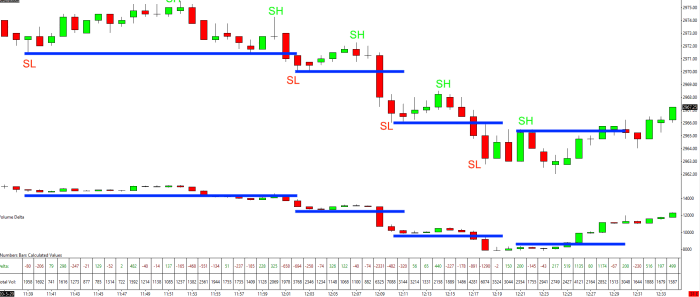
In the above example you will notice every time price breaks a swing low or swing high, delta does as well.
This makes sense as it takes selling pressure to break a swing low or buying pressure to break a swing high.
BUT….what’s occurring when this isn’t the case and we have divergence between price and delta?
Trading Exhaustion with Delta
Exhaustion: When less buyers are willing to buy at new highs or when less sellers are willing to sell at new lows, represented by delta.
On the above chart notice how price breaks out to new highs but Delta doesn’t follow through.
When this occurs the buyers are said to be “Exhausted” as they aren’t interested in buying at the new highs.
You can see above how the exhausted buyers began to liquidate their positions driving price down.
Let’s take a look at another exhaustion setup.
In this example price is now making new lows but delta wasn’t able to. The sellers are now said to be “Exhausted” as they aren’t interested in selling at these new lows.
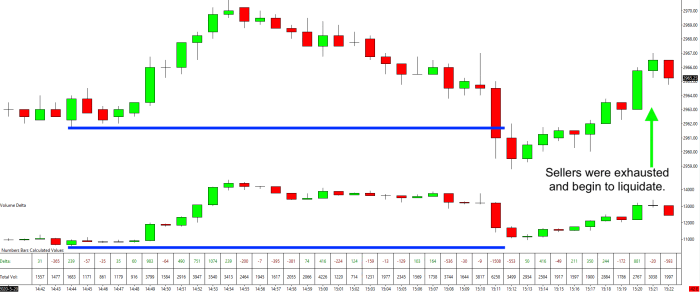
The end result was the exhausted sellers began liquidating their positions driving price up.
Trading Absorption with Delta
Absorption: When aggressive buyers are unable to take price to new highs or when aggressive sellers are unable to take price to new lows. The aggressive buying or selling pressure is being “Absorbed”.

In the above example delta is making new lows but price isn’t following through. Even though there’s aggressive selling pressure, that pressure is being “Absorbed” by the buyers.
Resulting in a rally as seen above.
In the next example, delta is making new highs but price doesn’t follow through. Can you guess what’s occurring here?
The buying pressure was “Absorbed” by the sellers resulting in a sell off.
Cumulative Delta & Trade Management
Delta not only will help you spot major reversals, but it can be used to help manage your open trades as well. When in a position, whether long or short, you want to see high correlation between delta and price.
If you’re long while price is breaking new highs you want to see delta breaking highs as well. If buyer’s aren’t interested in buying at the new highs, represented by delta not breaking highs, the probability of a reversal increases.
If you’re short while price is breaking new lows you want to see delta breaking lows as well. If sellers aren’t interested in selling at the new lows, represented by delta not breaking lows, the probability of a reversal increases.
When in a position always be on the look out for exhaustion and absorption signaling a potential of a reversal.
